Dangerous Inflationary Side Effects of G20 Ultra-Easy Money
Economics / Inflation Oct 29, 2009 - 11:56 AM GMTBy: Gary_Dorsch
 Operating under the elixir of ultra-low interest rates, and flush with trillions of fiat currency at their disposal, courtesy of the world’s top-20 central banks, hedge funds and banking Oligarchs are once again making risky and daring bets in commodities, emerging markets, junk bonds, and blue-chip stocks, defying gravity with trades that would have been un-thinkable just six-months ago.
Operating under the elixir of ultra-low interest rates, and flush with trillions of fiat currency at their disposal, courtesy of the world’s top-20 central banks, hedge funds and banking Oligarchs are once again making risky and daring bets in commodities, emerging markets, junk bonds, and blue-chip stocks, defying gravity with trades that would have been un-thinkable just six-months ago.
In order to engineer a 180-degree turnaround in trader psychology, from the chronic fear of meltdowns last year, to the opposite side of the spectrum - the euphoric illusions of V-shaped recoveries, the “Group-of-20” have committed $12-trillion of taxpayer money, equivalent to a fifth of the entire globe’s annual economic output. The G-20’s largesse has been used to fund capital injections into banks, soaking-up toxic assets, guaranteeing financial company debt, and flooding the world credit and stock markets with ultra-cheap liquidity.
On Sept 20th, the G-20 nations, which account for 90% of the world’s output, agreed it was too soon to begin withdrawing the $5-trillion of surplus cash that’s been injected into world money markets. The IMF estimates that banks in Britain, the Euro-zone, and the United States have recognized slightly less than half of the $3.4-trillion of bad loans sitting on their books, and are still struggling to absorb heavy losses primarily from failing US mortgage loans.
The G-20 says its drawn-up plans for coordinated exit strategies that would drain trillions of dollars of liquidity, such measures are still seen unlikely until sometime next year. On Sept 25th, US Treasury chief Timothy Geithner noted that although the global economy has pulled back “from the edge of abyss” and was showing early signs of resuming growth, it’s too early to let-up on the monetary accelerator. “We still have a very long way to go,” he said.
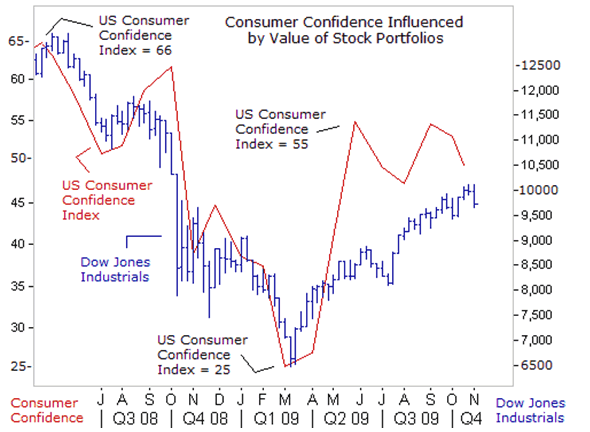
Lacking a better strategy for rescuing the banking system, and the global economy from plunging into another Great Depression, global central bankers fired-up their printing presses, aiming to inflate asset values on the stock exchanges. By artificially boosting investor portfolios with cheap money, the top-20 central bankers hoped to boost the confidence of households through the so-called “wealth effect.”
On March 16th, the Federal Reserve turned to the nuclear option of central banking, adopting a radical policy known as “Quantitative Easing,” (QE), announcing that it would print $1.75-trillion in order to purchase $300-billion of Treasury notes, and $1.45-trillion in mortgage backed bonds. By flooding the money markets with a steady torrent of zero-percent money, traders became more brazen and daring, willing to bid-up the Dow Jones Industrials by 54% over a span of six-months, one of just six rallies of that magnitude in the last 100-years.
By reaching the psychological 10,000-level, the Dow Industrials hit a spot that few could have imagined when the Dow skidded to a 12-year low of 6,497 on March 9th. The stock market’s gains were led by technology, industrial, and consumer stocks which normally feed on clear signs of an economic strength. Indeed, the US economy emerged from its deepest slump since the 1930’s, expanding at a +3.5% annual rate in the third quarter, - the early stages of a “technical” recovery.
Yet the US-jobless rate is also expected to continue climbing higher, above the psychological 10% level, signaling that severe economic distress still lies ahead. There have been eleven recessions since World War II. In the two most recent ones, -- July 1990-March 1991 and March-November 2001, - job growth lagged far behind after the recessions were declared over. The jobless rate did not fall to pre-recession levels for several years thereafter.
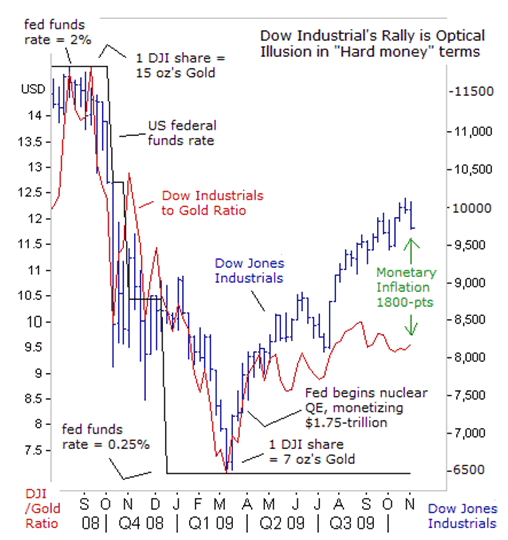
The lesser known U-6 jobless rate, including the long-term unemployed, and part timers seeking full-time work, is hovering at 17%, reminiscent of the Great Depression era. Thus, the US-stock market has been climbing a “wall of worry,” amid a cautious sense of optimism, but also beset by underlying jitters, that the economy faces a rocky road and the Dow Industrials might not stay above 10,000 for long.
When measured in “hard money” terms, or in relation to the price of gold, the Dow Industrials is trading at 9.5-ounces, - the same exchange rate that prevailed when the Dow was at the 8,200-level in January. Thus, utilizing this simple measure of valuation, - more than half of the Dow’s post March 10th rally, or roughly 1,800-points, is simply an optical illusion. More specifically, a stock market bubble has been inflated by the Fed’s QE money printing scheme.
Speculators are profiting from the hallucinogenic side-effects of “nuclear QE,” but the stock market’s spectacular gains haven’t spread to the wider economy. Instead, the money being pumped in via central banks is in fact, inflating bubbles. Oligarchic banks are reportedly hoarding much of the excess cash, parking funds in government and corporate bonds, commodities, and equities. In the last stage of a bubble, traders believe there is easy money to be made, and begin plowing their gains back into the market in a virtuous cycle. Price-to Earnings ratios get pumped up to high levels that can’t be sustained through top-line revenue growth.
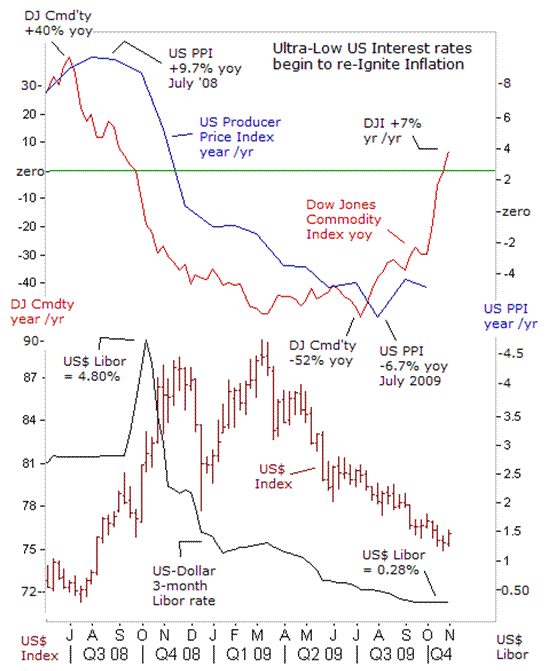
Martin Meyer, in his book “The Fed,” wrote, “The truth is that liquidity is the only significant weapon remaining in the central bank’s arsenal as decision making moves to the markets. Liquidity will not necessarily go, where you want it to go, when you need it to go there.” Thus, while the Fed would prefer for the tidal wave of liquidity to flow strictly into bonds and stocks, one of the dangerous side effects of QE is that much of the excess cash is also filtering into the commodities markets, - a signal that faster inflation lies ahead, even if much of its is generated by faster growing economies in the Far East and the emerging world.
Interest rates for US-dollar deposit rates in London’s Libor market have declined to a record low of just 0.28%, making the US-dollar unattractive to foreign lenders, who are already frightened by the prospect of trillions of US debt to hit the markets in the years ahead. Amid fears the Fed will ultimately succumb to political pressures and monetize the debt, the US-dollar fell to a 14-month low, lifting the Euro currency to the psychological $1.500 area, and the Swiss franc to parity of $1.00.
In turn, a weaker US-dollar exerted upward pressure on key commodities, such as crude oil, copper, rubber, iron-ore, nickel, and soybeans, leading to the rapid unwinding of deflationary pressures in the commodities markets. In the past four months alone, the Dow Jones Commodity Index, a basket of 19-exchange traded commodities, has rebounded from an annualized decline of -52% in early July, and surged into positive territory hitting +7% last week. Typically, as goes the direction of commodities markets, so goes the direction of the Producer Price Index.
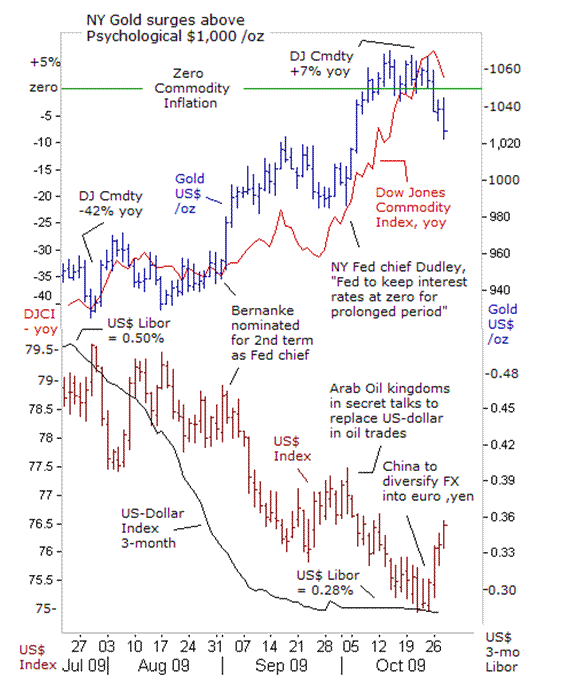
The combination of ultra-low US$ Libor rates, a sliding US-dollar, higher commodity prices, lifted the gold market above the psychological $1,000 /oz level, where it’s managed to stay for an entire month. In a virtuous cycle, gold’s rally mirrored the rapid unwinding of deflationary pressures in the commodities markets. As such, gold might become the next asset bubble if G-20 central banks continue to print money.
This is especially true in the event of a currency crisis in which gold’s buying power will increase from a devalued US-dollar in the currency markets. The US-dollar has been under selling pressure since October 6th newspaper report said the Arab Oil kingdoms in the Persian Gulf are secretly aiming to replace the US-dollar with a basket of currencies in exchange for their crude oil. The basket of currencies reportedly includes the Japanese yen, Chinese yuan and Euro, as well as Gold.
Whether these secret maneuvers are fact or fiction, the US-dollar did briefly tumble to a 14-month low after the People’s Bank of China (PBoC) vice-governor Yi Gang advised Beijing to increase its share of Euros and yen within its $2.25-trillion stash of foreign currency reserves. “The diversification of China’s foreign exchange reserves in different currencies is our long-standing policy,” he said.
Bank of England overdosing on Nuclear QE,
The Bank of England has also been overdosing on the hallucinogenic QE drug, and its decision to pump an extra 50-billion pounds into the UK money markets last August, left many traders convinced that it laid the groundwork for future inflation. Since, the BoE boosted its gilt buying binge to 175-billion pounds ($293 billion), equal to 12% of Britain’s annual economic output, the newly created money has been used to buy all asset classes, including gilts, equities, gold, and commodities.
Yet on October 26th, Adam Posen, a member of the BoE’s monetary policy committee argued that, “there is no evidence from relevant periods of UK or other major economies’ economic history, that QE will result in high or sustained inflation. Thus, high inflation is not something we should be worrying about,” he declared in a self serving manner, in order to cover-up the BoE’s nasty deeds.
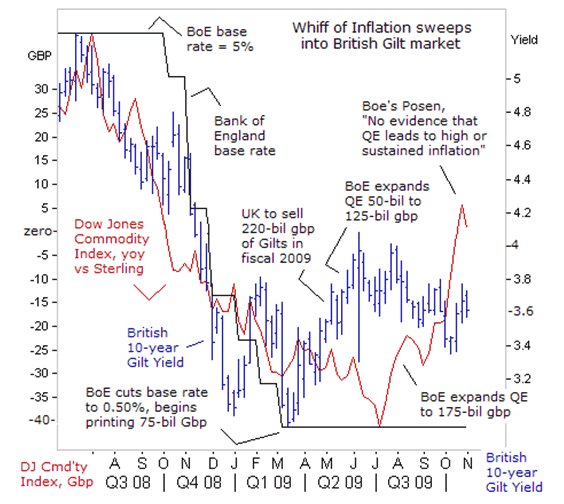
The annualized rate of change for the Dow Jones Commodity Index, measured in sterling, has zoomed sharply higher since July, pushing into positive territory for the first time in a year, signaling inflationary pressures are brewing beneath the surface. Yet the BoE’s Posen is still opposed to lifting interest rates anytime soon. “The banking system must be largely fixed before stimulus is withdrawn. The alternative is a still-born recovery, a double-dip recession, or persistently slow growth.”
Still, another major threat to the global stock markets would be a further surge in commodities that stokes fears of inflation, and in turn, leading to a sharp increase in government and corporate bond yields. A 1% increase in 10-year yields could deal a powerful blow to housing markets, and by extension, leading to greater tension in the banking system, as mortgage values slide.
Despite the rapid surge in commodity inflation since July, so far, yields on the benchmark 10-year British gilt are little changed from a year ago, hovering near 3.65-percent. There is a tug-of-war between fears of faster inflation, putting a floor under gilt yields, and on the other side of the coin, - the BoE’s ultra-low base rate, combined with its purchases of three-quarters of this year’s gilt supply, are acting to keep a lid on 10-year yields.
However, on October 29th, the BoE said it had completed its gilt purchases under its current 175 billion pound quantitative easing target. The BoE will decide whether to extend the asset purchase scheme next week, “The Monetary Policy Committee will review whether the scale of the asset purchase program should be changed at its November meeting, alongside its latest inflation projections,” the BoE said.
Risk of Global “Oil Shock,”
Another dangerous side-effect of the Fed’s devaluation the US-dollar, engineered in order to boost US exports and the profitability of S&P-500 multinationals is the risk of triggering another global “Oil Shock,” which in turn, could rattle the global economy and stock markets. US light crude oil prices surged to $82 /barrel last week, as the Euro currency reached $1.500 vs the greenback.
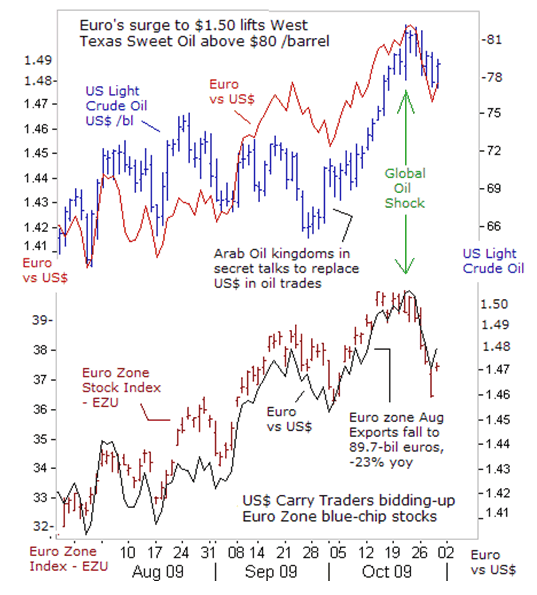
Oil prices might hit $100 a barrel in the months ahead, if the Euro were to climb to $1.600, thus backfiring on the Fed’s strategy of artificially inflating stock values. It might already be true that $80 /barrel is high enough to derail the global recovery, but a surge $100 a barrel could trigger a worldwide double-dip recession, and higher unemployment, leaving the EuroStoxx Index, which is trading at nosebleed levels of 50-times earnings, at great risk of a correction.
Other stock markets based in oil importing nations would also feel the ripple effect of a surge in oil prices. Ironically, US$ carry traders who are simultaneously selling the US-dollar and buying the Euro, in order to buy Euro-zone blue chip stocks, are also exerting upward pressure on oil prices, through the US-dollar’s devaluation. Thus, the carry trade strategy is boomeranging on EuroStoxx investors, while creating new headaches for the G-20 central banks.
Liquidity bubbles could begin to deflate next year. Bundesbank chief Axel Weber declared on October 29th, “Banks should prepare for a “gradual withdrawal of the medicine provided by central banks.” The withdrawal of emergency liquidity is likely to “play an important role next year” and indicated it may precede interest-rate increases, since the ECB sees risks to price stability.
This article is just the Tip of the Iceberg of what’s available in the Global Money Trends newsletter. Subscribe to the Global Money Trends newsletter, for insightful analysis and predictions of (1) top stock markets around the world, (2) Commodities such as crude oil, copper, gold, silver, and grains, (3) Foreign currencies (4) Libor interest rates and global bond markets (5) Central banker "Jawboning" and Intervention techniques that move markets.
By Gary Dorsch,
Editor, Global Money Trends newsletter
http://www.sirchartsalot.com
GMT filters important news and information into (1) bullet-point, easy to understand analysis, (2) featuring "Inter-Market Technical Analysis" that visually displays the dynamic inter-relationships between foreign currencies, commodities, interest rates and the stock markets from a dozen key countries around the world. Also included are (3) charts of key economic statistics of foreign countries that move markets.
Subscribers can also listen to bi-weekly Audio Broadcasts, with the latest news on global markets, and view our updated model portfolio 2008. To order a subscription to Global Money Trends, click on the hyperlink below, http://www.sirchartsalot.com/newsletters.php or call toll free to order, Sunday thru Thursday, 8 am to 9 pm EST, and on Friday 8 am to 5 pm, at 866-553-1007. Outside the call 561-367-1007.
Mr Dorsch worked on the trading floor of the Chicago Mercantile Exchange for nine years as the chief Financial Futures Analyst for three clearing firms, Oppenheimer Rouse Futures Inc, GH Miller and Company, and a commodity fund at the LNS Financial Group.
As a transactional broker for Charles Schwab's Global Investment Services department, Mr Dorsch handled thousands of customer trades in 45 stock exchanges around the world, including Australia, Canada, Japan, Hong Kong, the Euro zone, London, Toronto, South Africa, Mexico, and New Zealand, and Canadian oil trusts, ADR's and Exchange Traded Funds.
He wrote a weekly newsletter from 2000 thru September 2005 called, "Foreign Currency Trends" for Charles Schwab's Global Investment department, featuring inter-market technical analysis, to understand the dynamic inter-relationships between the foreign exchange, global bond and stock markets, and key industrial commodities.
Copyright © 2005-2009 SirChartsAlot, Inc. All rights reserved.
Disclaimer: SirChartsAlot.com's analysis and insights are based upon data gathered by it from various sources believed to be reliable, complete and accurate. However, no guarantee is made by SirChartsAlot.com as to the reliability, completeness and accuracy of the data so analyzed. SirChartsAlot.com is in the business of gathering information, analyzing it and disseminating the analysis for informational and educational purposes only. SirChartsAlot.com attempts to analyze trends, not make recommendations. All statements and expressions are the opinion of SirChartsAlot.com and are not meant to be investment advice or solicitation or recommendation to establish market positions. Our opinions are subject to change without notice. SirChartsAlot.com strongly advises readers to conduct thorough research relevant to decisions and verify facts from various independent sources.
Gary Dorsch Archive |
© 2005-2022 http://www.MarketOracle.co.uk - The Market Oracle is a FREE Daily Financial Markets Analysis & Forecasting online publication.



